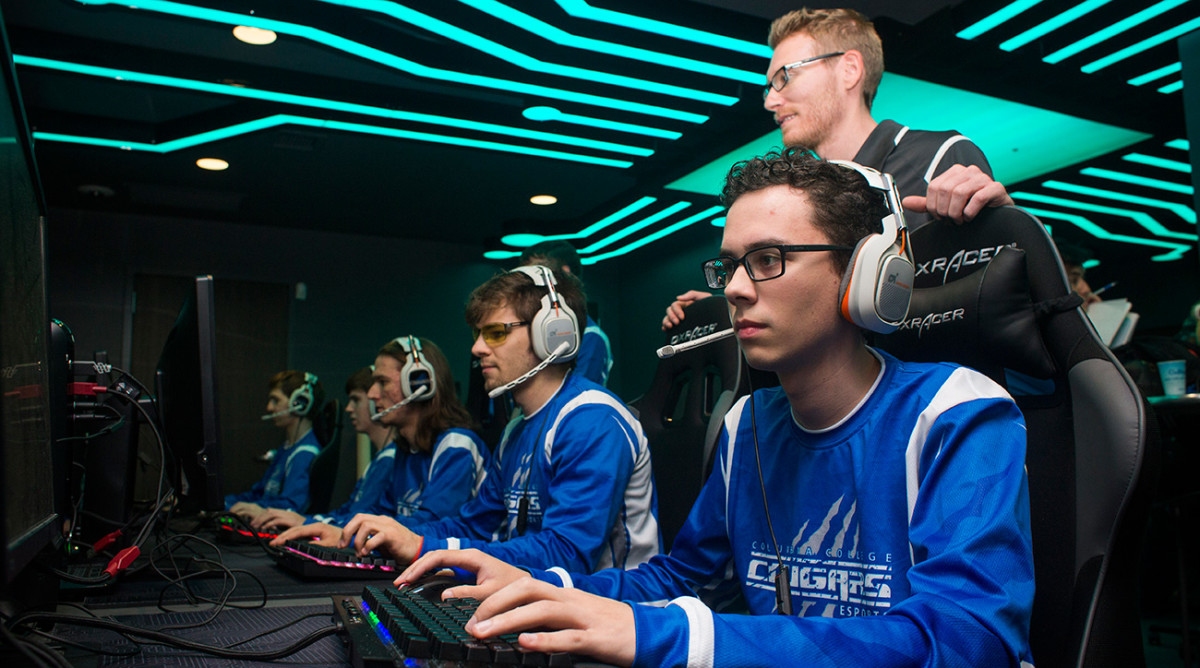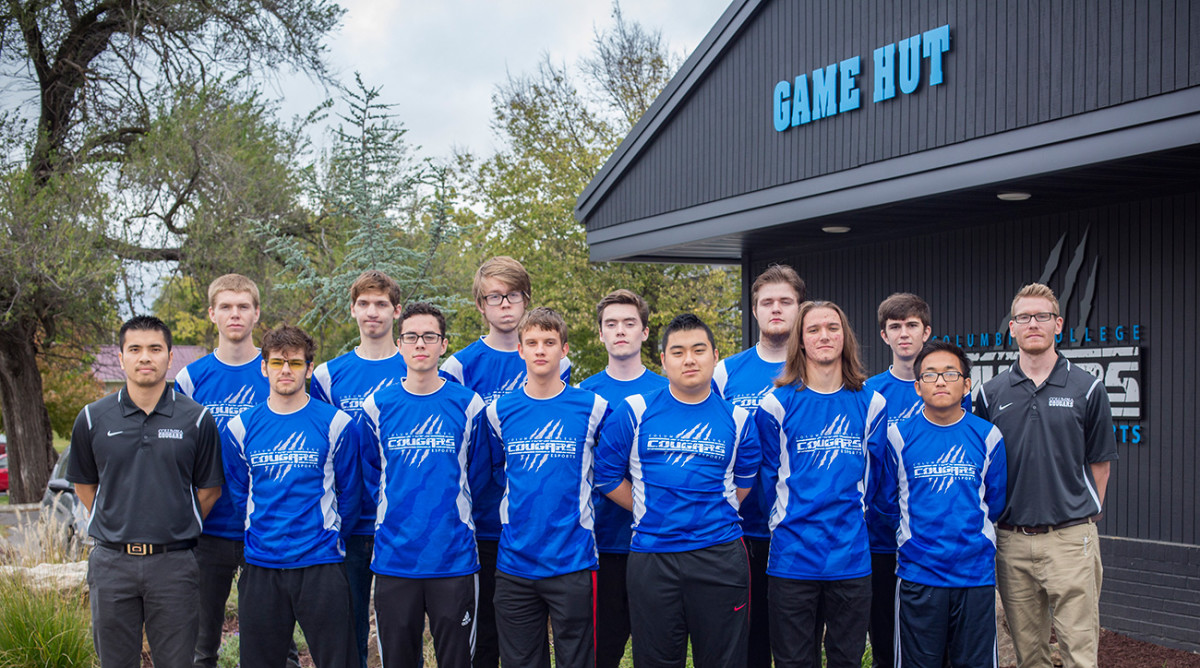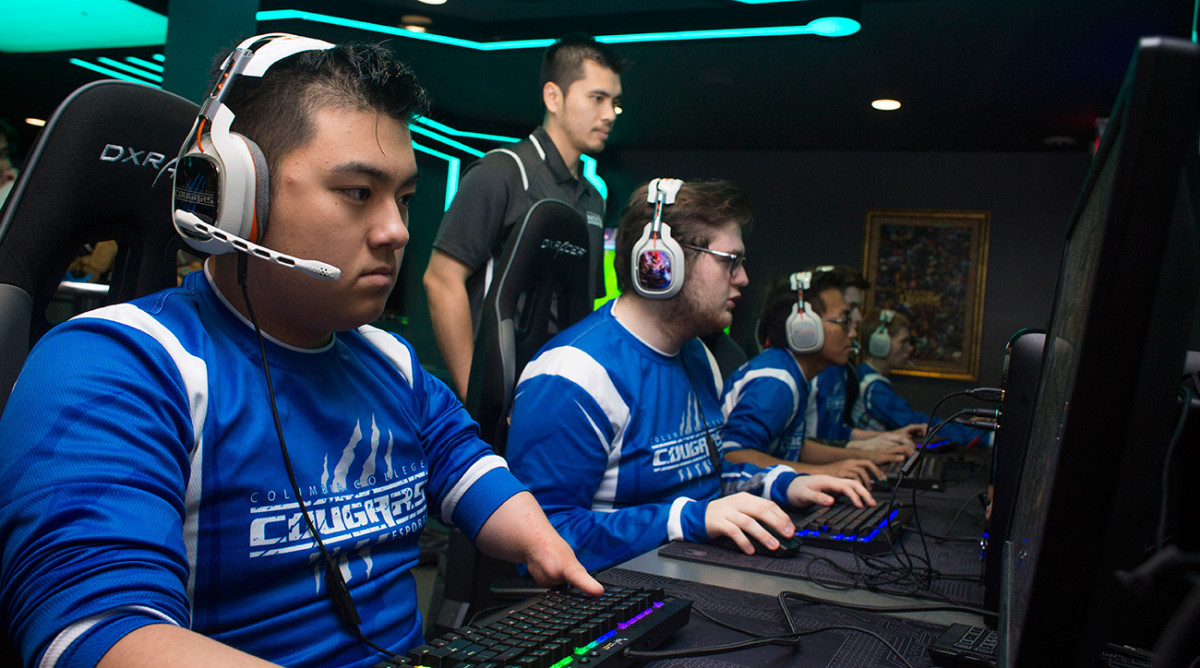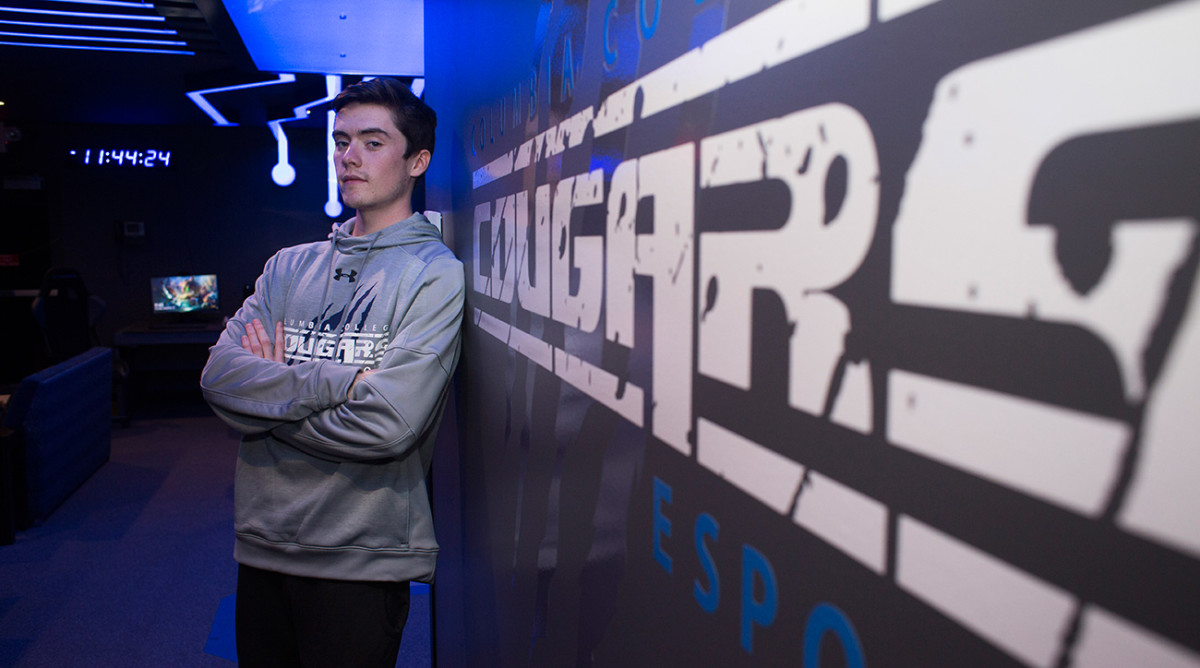What it's like to be a varsity esports player

COLUMBIA, Mo. — Connor Doyle’s days often began and ended the same way: too depressed to do anything other than smoke weed and play League of Legends. Not being able to deal with real life, he says, made him a good League player. A fantasy world, a square jungle inhabited by magical, weapon-toting creatures, is where he began to feel most at home.
In 2012, he came to Colby College, an elite liberal arts school about 30 minutes from his hometown of Winthrop, Maine, to major in math and economics and—he hoped—play Division III soccer. He stands 6 feet tall with legs that disappear in jogger pants and has pale, veiny arms, but he prepared with 4,000-calorie days and 40 miles of running each week in his final semester of high school. He came to college a couple of weeks early for tryouts, but he didn’t make the team. The three-sport captain in high school changed. “Lost my identity,” he says.
He attached himself to a new goal, an engineering dual-degree program involving Colby and Dartmouth. Only about 10 students are accepted each year, and Doyle didn’t make the cut as a sophomore. As he began failing school, he succumbed to ugly vices. In Fall 2015, he consumed a quarter ounce of weed each week and would snort Adderall before nights of partying. And he was “latched onto League, which was his greatest passion,” says Chris Leete, a former roommate and close friend.
Doyle needed a way to fill the competitive void created by the loss of sports, so he regularly skipped class to play League. The drugs were simply a means to cope with failing in school.
Obsessions can cripple and rebuild us. And here League did both. Doyle might lead one of the first collegiate varsity esports programs to a national championship this spring, but first he had to lose his life at Colby.
So when he came home from the first day of final exams that Fall at Colby, he was wide-eyed and tired. “He sort of look semi-frightened and frazzled,” Leete says. “You could tell he didn’t want to think about it after it happened.” So he didn’t. He smoked a dab, a concentrated oil form of marijuana—and he played more League. And on the final day of exams, he skipped out on his roommates, who he was supposed to complete a take-home exam with, and called his father to come pick him up. He’d spent his parents’ money on drugs—but really, he says, he was “addicted to League.” He left Colby in a disorganized hurry. “He left like all his s---,” Leete says, “except his gaming stuff.”

League of Legends is a multiplayer online battle arena game, or MOBA. The goal is to destroy the other team’s nexus, which lies inside the opponent’s base. Champions, controlled by summoners, grow stronger over the course of the game as they gain experience battling other players and computer-controlled enemies. The five-on-five game requires champions to traverse various landscapes— jungles with boulders, rivers and dragons. Maps are built on a square with three lanes to the opposite corners where bases are—one cutting diagonally across, and two others running along the perimeter of the square.
The game boasts more than 100 million monthly active players worldwide. Matches have sold out the 21,000-seat Staples Center in Los Angeles, and 36 million people watched the final of the 2015 World Championships. Doyle began playing as a freshman in high school. There was a club League team at Colby, but it wasn’t serious enough for Doyle, who plays while wearing a compression sleeve on his right arm to deal with nerve issues and to serve as a mental cue that “it’s game time.”
Doyle admires Real Madrid star Cristiano Ronaldo because he thinks Ronaldo’s ego blinds him from seeing that soccer’s other major star, Lionel Messi, is the better player. His favorite esports athlete is Yiliang Peng, an uber-competitive 23-year-old from Orange County who goes by Doublelift and who plays for Doyle’s favorite pro esports team, Team SoloMid.
Doyle, who ranks among the top .07% of all League players, wants a career like Doublelift, or really anything close to the about $1 million Doublelift makes each year off his professional contract and streaming opportunities. After withdrawing from Colby, Doyle developed a plan. Play League for a varsity collegiate program and—he hoped—land on a professional team after a couple years. A competitive college team would give him exposure, and his parents said O.K. They just wanted him to graduate from college.
At Columbia College, Doyle found a school whose ambitions mirrored his own. Everyone associated with the program—the players, the two coaches, the assistant athletic director, school president Scott Dalrymple—talks about winning a national title in Year One.
Media Circus: The best journalism of 2016
For his inauguration as Columbia’s president in October 2014, Dalrymple held a Madden tournament. The video announcing the competition—which featured him sitting at a desk in front of a dark wooden shelf full of books—went viral. If a student could beat him, that person would win free textbooks and a year’s worth of pizza. “From this one-pop crucible of competition, one student will emerge, hardened like a piece of steel forged in the fires of Mount Doom,” he says in the video.
The school, which has a student body of about 3,000 on its flagship campus and competes in the NAIA for traditional sports, wanted to capitalize on the publicity. A committee formed to decide how to harness video games’ popularity, and esports—competitive video gaming—was one of its first ideas. So in October 2015, the school established a 12-player League of Legends program. It was just the fifth collegiate varsity esports program in the country. The college transformed a former soccer locker room into a “Game Hut” and went looking for players to whom they could offer 30% scholarships.
In March 2016, Doyle became Columbia’s first esports signee. And that spring, once he’d begun practicing with his Columbia teammates but hadn’t yet left for Missouri, he visited his friends at Colby—and he didn’t use drugs. He didn’t feel the need to. He had purpose again; League was no longer just an intense hobby.
“I never met anyone as passionate, as smart,” says Jon Song, a teammate who played with Doyle before signing and called Doyle “70%” of the reason he transferred to Columbia.
Columbia has two teams, Blue and Silver, both of which feature all-male rosters. (The program is open to being co-ed but found no suitable female recruits.) Blue is the unofficial A team, the one that will compete in the University League of Legends (uLoL) Campus Series, starting on Jan. 14, for the chance to win $40,000 in scholarship money, and Doyle is Blue’s “shot-caller,” the captain and player-coach who directs the team’s in-game decisions.
Whether Doyle effectively leads a group of players in League—a game that has always required team work but only recently became a team game, with players competing in the same space—will determine how fast Columbia makes good on its esports investment — the total figure for which Columbia, a private institution, declines to provide. And Doyle’s performance will determine whether he makes good on his plan.

League games are fast-paced, sometimes lasting less than 30 minutes, and it can be difficult, as an observer, to understand what players are thinking during a match.
But during a frozen moment after he hits the space bar one fall morning inside Columbia’s game hut, Doyle talks through his issues with one recent scrimmage. RJ Bohnak, the team’s jungler, who operates in the area between the three lanes teammates occupy, annoyed him. Bohnak is loud—often yelling and pounding his feet when he kills someone—and he can be reckless.
He has entered into enemy territory early, attempting to poach the opponent’s resources, but he has fallen under attack. Doyle doesn’t want to leave his position to help Bohnak. It’s early in the game, and Doyle has 10 creeps—easily killable, computer-controlled minions—in front of him to slaughter. His opponent, also standing in this grassy area near one Columbia’s laser-spewing turrets, has just six creeps to kill. So if Doyle leaves, he’ll be giving up a four-creep advantage, and creeps equal gold.
Sports Illustrated Media Awards: The best and worst of 2016
Doyle hits the spacebar again, moving the game film forward just a bit. Muffled sound of in-game dialogue on headsets plays. “I can not come over,” Doyle says to Bohnak. “I can’t come.”
If Bohnak dies, that’s worth about 350 gold for the opponent. In total, the creeps in front of Doyle are worth about 180. So saving Bohnak is, potentially, the better play. “But it’s not that exact science,” Doyle says. “Three things are certain right now: death, taxes and minions are going to die at this turret.” The river fight he’d engage in to save Bohnak, though, is conditional. “For us to win this three-versus-three engagement, what has to happen?” he asks. And now he’s talking faster as he runs off the list of the six things that would need to go right to save Bohnak. “It’s a probability scheme.” Staying put, he figures, is likely to yield him more gold on average.
He had these same thoughts while playing the game in real-time, while dodging attacks from opponents, killing minions and collecting gold. He likes to think of the game as a binary tree—one branch becomes two, and two become four as each branch represents a separate decision that leads to a unique outcome.
He unpauses the film. Doyle stays put, and the opponent rotates into the jungle to kill Bohnak. “But look,” he says in a happy tone, “these creeps are dying.”

One night in early October, David Williams, a performance psychologist, is on campus to give a speech to the school’s athletes. First, though, he’s hosting a private session with the esports team. “What I want to know is what the heck you guys do,” he begins by saying.
Doyle is the most engaged of any player. He’s sitting near the back, next to head coach Duong Pham, and he’s answering most of the questions—including this one.
“There are opportunities to make decisions throughout the game,” he says. He explains what he loves about League, how dependent it is on each decision and the potential pressure that comes with that element of the game. “There’s this word we call ‘tilt.’”
Columbia uses the word, which has its roots in poker, as a catchall for any mental state that isn’t calm or prepared. Upset? Tilted. Flustered? Tilted. Mad? Tilted. “That is a really important thing to combat before [a match] starts,” Doyle says. “It can be something that loses you a series. So when I think of performance psychology and League of Legends, I think being tiltless.”
“Yeahhhh, tiltless,” Williams says. “I love that. I want to trademark that.”
“You can’t,” Doyle deadpans. “I already did.”
Most of the room laughs, but not every player is enthralled to be here. Not all of them take the game and all that comes with it as a varsity athlete as seriously as Doyle, whom they jokingly call “Douchebag Doyle.” Two other members of Columbia Blue asked to switch to Silver because they felt Doyle was too controlling. Coaches let them switch—and then they switched back to be with the better team.
Student journalists discuss the future of sports media
Those two players, Ian Alexander and Dean Wood, are sitting together on the other side of the room from Doyle. Williams has them put their hands on their stomachs to teach controlled breathing as a way calm their heart rates and minds, but they laugh. Doyle snaps his fingers, telling them to pay attention. Tilted.
Williams has the players puff their cheeks and exhale slowly. He tells the team the key to managing energy is in proper exhales. But Alexander, a 17-year-old with a faux-hawk, exhales fast and makes a farting sound.
“Think about it,” Williams says as the session closes. “How good would you be if you never went on tilt?”
“We’d probably win,” Doyle says, which is a big statement. Four hundred teams competed in the qualifying round of last year’s uLoL championship, with University of British Columbia ultimately winning its second straight North American title.
Being Columbia Blue’s shot-caller presents the most responsibility, the greatest sense of accountability — things Doyle, who occasionally drinks but no longer uses drugs, thinks he needs. League, he says, “was something I could grab onto ... and use that to literally pull me back up.”

It’s mid-October, and Columbia Blue is about to play its first match of the Imperial Pro League, a short-season fall league that offers a small cash prize. Doyle is the only player who shows up in his jersey, which Columbia players don’t have to wear until uLoL competition. It’s blue and white with the team’s logo on the front and his summoner name on the back. Doyle, who took five years of Latin classes, picked Artemis, the Greek goddess of the hunt, for his. He chose the name this summer, before he started streaming his own matches. He hopes to build a brand, which would make him more attractive to pro teams.
Doyle taps the end of a pen against his teeth while holding a pad of grid paper. He’s writing down potential lineups for the upcoming match. “Hey Ian,” he calls out while Alexander wears headphones and ignores him. “Hey Ian. Hey Ian.” Once more. “Yo Ian!”
He finally gets Alexander’s attention, and he suggests Jace, a handsome character with a hammer who looks like a cross between Iron Man and a Disney prince. Alexander counters with Quinn, a woman who fights with a large bird. Doyle presses him on how much he’s played Quinn. The last time was years ago.
“Come on man,” Doyle says. “Work with me. Poppy?”
“I just get s--- on with Poppy.”
“So what do you want to play then?”
“Quinn.”
Doyle tilts his head to the left. He’s annoyed with Alexander, who hasn’t taken his headphones off since the conversation began. As the match approaches, Doyle says he’s going to do a five-minute breathing exercise. He invites teammates to join, and Song does. They both close their eyes.
How Alabama and Clemson football fared in social media and technology this year
When it comes time to pick champions, Alexander picks Fiora, a woman who wields blue steel rapier. It probably wouldn’t have mattered. Blue wins handedly. The match is over in about 20 minutes, and Doyle steps outside to stretch his arms. Song joins him, and they start talking about Alexander.
“I was pretty tilted,” Song says.
“I was too,” Doyle says. “I wish he was a little less arrogant.”
“Less stubborn.”
“I’d never do that.”
Doyle is still learning how to manage personalities. But he’s making progress. He calls all of his teammates, even Alexander, his friends. And on this night, he appears to be buddies with Wood, one of the former Blue defectors. “Walk me through this Dean,” Doyle says to Wood, sitting next to him, as they watch Blue’s winning play of the second match. They both giggle, giddy from Columbia’s dominance.
“That does it for tonight, guys,” Doyle says into a webcam to the people who watched his live stream of the match. “Hope you guys enjoyed it.” He tells people to follow him on Twitter, Snapchat and Instagram and to add him on Facebook. He shares with the audience what’s next, going to study for a test. “Love you all.” He blows a playful kiss and stops the video stream. He keeps the chat room open for a few more minutes, though. “Why do you look drunk every time you do a scrim?” Doyle says, reading out a comment.
He is not drunk, nor is he high. “Because endorphins,” he says aloud and types as a response. Then he unplugs his keyboard. “O.K.,” he tells his teammates, “I need to go do things. I need to be an adult.”
